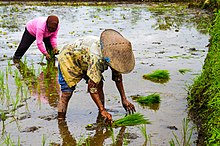User:Swastikdevgan/Sustainable agriculture
Traditional Agriculture[edit]

Often thought of as inherently destructive, slash-and-burn or slash-and-char shifting cultivation have been practised in the Amazon for thousands of years.[2]
Some traditional systems combine polyculture with sustainability. In South-East Asia, rice-fish systems on rice paddies have raised freshwater fish as well as rice, producing an additional product and reducing eutrophication of neighbouring rivers.[3] A variant in Indonesia combines rice, fish, ducks and water fern; the ducks eat the weeds that would otherwise limit rice growth, saving labour and herbicides, while the duck and fish manure substitute for fertilizer.[4]
Raised field agriculture has been recently revived in certain areas of the world, such as the Altiplano region in Bolivia and Peru. This has resurged in the form of traditional Waru Waru raised fields, which create nutrient-rich soil in regions where such soil is scarce. This method is extremely productive and has recently been utilized by indigenous groups in the area and the nearby Amazon Basin to make use of lands that have been historically hard to cultivate.
In Ohio, some farmers that could not buy land good for agriculture restored soil considered as unsuitable for any agricultural activity with traditional methods.[5]
Indigenous Agriculture[edit]

Native Americans in the United States practiced sustainable agriculture through their subsistence farming techniques. Many tribes grew or harvested their own food from plants that thrived in their local ecosystems. Native American farming practices are specific to local environments and work with natural processes.[6] This is a practice called Permaculture, and it involves a deep understanding of the local environment.[7] Native American farming techniques also incorporate local biodiversity into many of their practices, which helps the land remain healthy.[8]
Many indigenous tribes incorporated Intercropping into their agriculture, which is a practice where multiple crops are planted together in the same area. This strategy allows crops to help one another grow through exchanged nutrients, maintained soil moisture, and physical supports for one another. The crops that are paired in intercropping often do not heavily compete for resources, which helps them to each be successful. Intercropping also provides a natural strategy for pest management and the prevention of weed growth. Intercropping is a natural agricultural practice that often improves the overall health of the soil and plants, increases crop yield, and is sustainable.[7]
One of the most significant aspects of indigenous sustainable agriculture is their traditional ecological knowledge of harvesting. The Anishinaabe tribes follow an ideology known as "the Honorable Harvest". The Honorable Harvest is a set of practices that emphasize the idea that people should "take only what you need and use everything you take."[9] Resources are conserved through this practice because several rules are followed when harvesting a plant. These rules are to never take the first plant, never take more than half of the plants, and never take the last plant.[10] This encourages future growth of the plant and therefore leads to a sustainable use of the plants in the area.
Native Americans practiced agroforestry by managing the forest, animals, and crops together. They also helped promote tree growth through controlled burns and silviculture. Often, the remaining ash from these burns would be used to fertilize their crops. By improving the conditions of the forest, the local wildlife populations also increased. Native Americans allowed their livestock to graze in the forest, which provided natural fertilizer for the trees as well.[7]
- ^ Thurston, H. David (1992). Sustainable practices for plant disease management in traditional farming systems. Boulder, Colorado: Westview Press. p. 11. ISBN 978-0813383637.
- ^ Sponsel, Leslie E (1986). "Amazon ecology and adaptation". Annual Review of Anthropology. 15: 67–97. doi:10.1146/annurev.anthro.15.1.67.
- ^ Burchett, Stephen; Burchett, Sarah (2011). Introduction to Wildlife Conservation in Farming. John Wiley & Sons. p. 268. ISBN 978-1-119-95759-1.
- ^ Bezemer, Marjolein (12 December 2018). "Mixed farming increases rice yield". reNature Foundation.
- ^ "Ohio Farmers Use Old-Fashioned Methods to Turn Degraded Land into Green Pasture". Yale Climate Connections. Ecowatch. November 8, 2019. Retrieved 10 November 2019.
- ^ Pace, Katie. "Indigenous Agriculture and Sustainable Foods". Sustainable Food Center. Retrieved 29 March 2021.
- ^ a b c Heim, Tracy (12 October 2020). "The Indigenous Origins of Regenerative Agriculture". National Farmers Union. Retrieved 29 March 2021.
- ^ Nabhan, Gary (1989). Enduring Seeds: Native American Agriculture and Wild Plant Conservation. Tucson: The University of Arizona Press. p. x.
- ^ Kimmerer, Robin (2013). Braiding Sweetgrass : Indigenous Wisdom, Scientific Knowledge and the Teachings of Plants. Milkweed Editions. p. 148.
- ^ Kimmerer, Robin (2013). Braiding Sweetgrass : Indigenous Wisdom, Scientific Knowledge and the Teachings of Plants. Milkweed Editions. p. 183.
